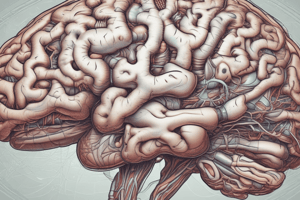Podcast
Questions and Answers
Cal é a función da Hipófise?
Cal é a función da Hipófise?
- Controlar a produción de hormonas do resto de glándulas (correct)
- Produtor de hormonas para o crescemento
- Regular a función do corazo
- Regular a actividade do sistema nervioso
Que parte do sistema nervioso central é responsable de elaborar as respostas para esquivar un estímulo físico?
Que parte do sistema nervioso central é responsable de elaborar as respostas para esquivar un estímulo físico?
- Cerebro
- Cerebelo
- Medula espiñal (correct)
- Bulbo raquídeo
Cal é a relación entre o Hipotálamo e a Hipófise?
Cal é a relación entre o Hipotálamo e a Hipófise?
- O Hipotálamo controla a Hipófise
- Na hai relación entre eles
- A Hipófise controla o Hipotálamo
- Ambos regulan o sistema endócrino (correct)
Que parte do sistema nervioso central se encarga de regular a actividade do corazo?
Que parte do sistema nervioso central se encarga de regular a actividade do corazo?
Cal é a función do Cerebelo?
Cal é a función do Cerebelo?
Qué é o corpo neuronal?
Qué é o corpo neuronal?
Qué é a substancia branca?
Qué é a substancia branca?
Qué é a función da micróglia?
Qué é a función da micróglia?
Qué é un estímulo?
Qué é un estímulo?
Qué é a sinapse?
Qué é a sinapse?
O que son os neurotransmisores?
O que son os neurotransmisores?
Que é o Alzhéimer?
Que é o Alzhéimer?
Que función desempeña o Sistema Nervioso Periférico Somático Parasimpático?
Que función desempeña o Sistema Nervioso Periférico Somático Parasimpático?
Que controla o equilibrio e a coordinación?
Que controla o equilibrio e a coordinación?
Que sentido segue o impulso nervioso nunha neurona?
Que sentido segue o impulso nervioso nunha neurona?
Que é o Hipotálamo?
Que é o Hipotálamo?
Flashcards are hidden until you start studying
Study Notes
Neurotransmitters and the Nervous System
- Neurotransmitters are released by dendrites.
- Alzheimer's disease is a neurodegenerative disorder of the Central Nervous System (CNS).
- The Peripheral Nervous System (PNS) has two divisions: the Somatic Nervous System and the Autonomic Nervous System, with the latter having two subdivisions: the Parasympathetic Nervous System, which relaxes, and the Sympathetic Nervous System, which acts in stress situations.
Brain Structure and Functions
- The accumulation of neuronal bodies with their dendrites appears gray in color.
- The medulla spinalis is responsible for reflex acts.
- The left hemisphere of the brain controls the right side of the body and vice versa.
- The cerebellum controls learning of balance and coordination.
Neuron Function and Impulse Transmission
- The impulse in a neuron moves in the following order: dendrites → cell body → axon → terminal buttons → other dendrites.
Meninges and Cerebrospinal Fluid
- The meninges are protective membranes of the Central Nervous System.
- The cerebrospinal fluid is located between the arachnoid and pia mater.
- The cerebrospinal fluid protects the Central Nervous System from shocks.
Hormone Regulation
- The hypothalamus controls hormone production and regulates the endocrine system along with the pituitary gland.
- The pituitary gland is the master endocrine gland that regulates other endocrine glands.
Short Answer Questions
- The meninges are protective membranes of the Central Nervous System.
- The cerebrospinal fluid is located between the arachnoid and pia mater.
- The cerebrospinal fluid protects the Central Nervous System from shocks.
- The hypothalamus controls hormone production and regulates the endocrine system.
- The pituitary gland is the master endocrine gland that regulates other endocrine glands.
Central Nervous System Responses
- The medulla spinalis is responsible for responding to external stimuli, such as avoiding an object.
- The bulbar raquídeo is responsible for regulating heart rate in response to stimuli, such as seeing an attractive person.
- The cerebellum is responsible for coordinating motor responses, such as avoiding an obstacle while biking.
Neuron and Brain Structure
- A neuron consists of a cell body, dendrites, membrane, cytoplasm, nucleus, axon, and terminal buttons.
- The brain consists of the cerebrum, cerebellum, bulbar raquídeo, and mesencephalon.
- The cerebral cortex has folds (circunvolutions) and grooves (sulci).
- The brain stem consists of the midbrain, pons, and medulla oblongata.
- The cerebellum has hemispheres and a vermis.
Inverse Definitions
- A stimulus is a change in external or internal conditions that can be detected by the body.
- White matter consists of axons coated with myelin.
- Microglia are cells responsible for defending the Nervous System.
- A synapse is the connection between two neurons.
Studying That Suits You
Use AI to generate personalized quizzes and flashcards to suit your learning preferences.




